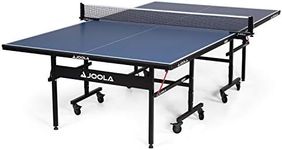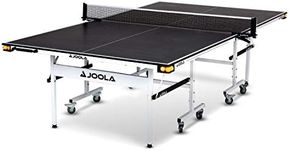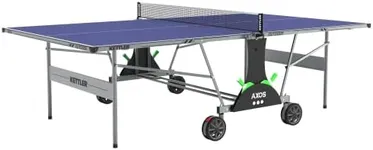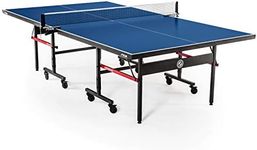Buying Guide for the Best Ping Pong Tables
Choosing the right ping-pong table can make a big difference in how much you enjoy the game, whether you’re playing casually with friends or practicing to improve your skills. Before you buy, think about where you’ll use the table, how often you’ll play, and who will be using it. Understanding the key features will help you find a table that fits your space, needs, and playing style.Tabletop ThicknessTabletop thickness refers to how thick the playing surface is, usually measured in millimeters. This is important because a thicker tabletop provides a more consistent and true bounce, which is crucial for a good playing experience. Thinner tables (around 12-15mm) are lighter and more affordable, but the bounce may be less predictable, making them better for beginners or casual play. Medium thickness (16-19mm) offers a balance between playability and portability, suitable for regular recreational use. Thicker tables (22mm and above) are used in clubs and competitions, providing the best bounce and durability, ideal for serious players. Choose the thickness based on how serious you are about the game and how much you value a professional playing experience.
Indoor vs. Outdoor UsePing-pong tables are designed for either indoor or outdoor use, and this affects their materials and durability. Indoor tables are made from materials that provide a great bounce but can be damaged by moisture or sunlight, so they should only be used in dry, climate-controlled spaces. Outdoor tables are built with weather-resistant materials like aluminum or treated wood, making them suitable for patios, gardens, or garages. If you plan to leave your table outside or in a humid area, choose an outdoor model. If you have a dedicated indoor space, an indoor table will give you the best playing surface.
Table SizeStandard ping-pong tables are 9 feet long, 5 feet wide, and 2.5 feet high, which is the official size for tournaments. However, smaller tables are available for those with limited space or for children. Full-size tables are best for adults and anyone who wants to practice for competition, while mid-size or compact tables are easier to fit in smaller rooms and are more portable. Consider the space you have available, including room around the table for movement, before deciding on the size.
Portability and StoragePortability refers to how easy it is to move and store the table. Some tables fold up and have wheels, making them easy to roll away and store when not in use. Others are fixed and require more effort to move. If you need to set up and take down the table frequently, look for a model with easy folding mechanisms and lockable wheels. If the table will stay in one place, portability is less important.
Frame and Leg ConstructionThe frame and legs support the table and affect its stability and durability. Stronger frames, often made from steel or thick aluminum, provide better support and last longer, especially if the table will be moved often or used by many people. Lighter frames are easier to move but may wobble during play. If you want a sturdy, long-lasting table, look for robust frame construction. For occasional or light use, a lighter frame may be sufficient.
Net and Post SystemThe net and post system holds the net in place and can vary in quality and ease of use. Some nets are permanently attached, while others are removable and adjustable. A good net system should be easy to set up, adjust, and replace if needed. If you plan to play often or want to practice seriously, look for a sturdy, adjustable net system. For casual play, a basic net will suffice.













